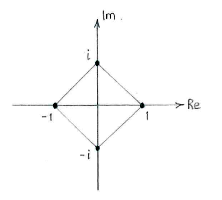Lösung 3.3:2a
Aus Online Mathematik Brückenkurs 2
K (Lösning 3.3:2a moved to Solution 3.3:2a: Robot: moved page) |
|||
| Zeile 1: | Zeile 1: | ||
| - | {{ | + | An equation of the type “ |
| - | < | + | <math>z^{n}</math> |
| - | {{ | + | = a complex number” is called a binomial equation and these are usually solved by going over to polar form and using de Moivre's formula. |
| - | {{ | + | |
| - | < | + | We start by writing |
| - | {{ | + | <math>z\text{ }</math> |
| + | and | ||
| + | <math>\text{1}</math> | ||
| + | in polar form | ||
| + | |||
| + | |||
| + | <math>\begin{align} | ||
| + | & z=r\left( \cos \alpha +i\sin \alpha \right) \\ | ||
| + | & 1=1\left( \cos 0+i\sin 0 \right) \\ | ||
| + | \end{align}</math> | ||
| + | |||
| + | |||
| + | The equation then becomes | ||
| + | |||
| + | |||
| + | <math>r^{4}\left( \cos 4\alpha +i\sin 4\alpha \right)=1\left( \cos 0+i\sin 0 \right)</math> | ||
| + | |||
| + | |||
| + | where we have used de Moivre's formula on the left-hand side. In order that both sides are equal, they must have the same magnitude and the same argument to within a multiple of | ||
| + | <math>2\pi </math>, i.e. | ||
| + | |||
| + | |||
| + | <math>\left\{ \begin{array}{*{35}l} | ||
| + | r^{4}=1 \\ | ||
| + | 4\alpha =0+2n\pi \quad \left( n\text{ an arbitrary integer} \right)\text{ } \\ | ||
| + | \end{array} \right.</math> | ||
| + | |||
| + | This means that | ||
| + | |||
| + | |||
| + | <math>\left\{ \begin{array}{*{35}l} | ||
| + | r=1 \\ | ||
| + | \alpha =\frac{n\pi }{2}\quad \left( n\text{ an arbitrary integer} \right)\text{ } \\ | ||
| + | \end{array} \right.</math> | ||
| + | |||
| + | The solutions are thus (in polar form) | ||
| + | |||
| + | |||
| + | <math>z=1\centerdot \left( \cos \frac{n\pi }{2}+i\sin \frac{n\pi }{2} \right)</math>, for | ||
| + | <math>n=0,\ \pm 1,\ \pm 2,...</math> | ||
| + | |||
| + | |||
| + | but observe that the argument on the right-hand side essentially takes only four different values | ||
| + | <math>0,\ {\pi }/{2}\;,\ \pi </math> | ||
| + | and | ||
| + | <math>{3\pi }/{2}\;</math>, because other values of | ||
| + | <math>n\text{ }</math> | ||
| + | give some of these values plus/minus a multiple of | ||
| + | <math>2\pi </math>. | ||
| + | |||
| + | The equation's solutions are therefore | ||
| + | |||
| + | |||
| + | <math>z=\left\{ \begin{array}{*{35}l} | ||
| + | 1\centerdot \left( \cos 0+i\sin 0 \right) \\ | ||
| + | 1\centerdot \left( \cos {\pi }/{2}\;+i\sin {\pi }/{2}\; \right) \\ | ||
| + | 1\centerdot \left( \cos \pi +i\sin \pi \right) \\ | ||
| + | 1\centerdot \left( \cos {3\pi }/{2}\;+i\sin {3\pi }/{2}\; \right) \\ | ||
| + | \end{array} \right.=\left\{ \begin{matrix} | ||
| + | 1 \\ | ||
| + | i \\ | ||
| + | -1 \\ | ||
| + | -i \\ | ||
| + | \end{matrix} \right.</math> | ||
| + | |||
| + | |||
| + | NOTE: note that if we mark these solutions on the complex number plane, we see that they are corners in a regular quadrilateral. | ||
| + | |||
[[Image:3_3_2_a.gif|center]] | [[Image:3_3_2_a.gif|center]] | ||
Version vom 09:04, 24. Okt. 2008
An equation of the type “ \displaystyle z^{n} = a complex number” is called a binomial equation and these are usually solved by going over to polar form and using de Moivre's formula.
We start by writing \displaystyle z\text{ } and \displaystyle \text{1} in polar form
\displaystyle \begin{align}
& z=r\left( \cos \alpha +i\sin \alpha \right) \\
& 1=1\left( \cos 0+i\sin 0 \right) \\
\end{align}
The equation then becomes
\displaystyle r^{4}\left( \cos 4\alpha +i\sin 4\alpha \right)=1\left( \cos 0+i\sin 0 \right)
where we have used de Moivre's formula on the left-hand side. In order that both sides are equal, they must have the same magnitude and the same argument to within a multiple of
\displaystyle 2\pi , i.e.
\displaystyle \left\{ \begin{array}{*{35}l}
r^{4}=1 \\
4\alpha =0+2n\pi \quad \left( n\text{ an arbitrary integer} \right)\text{ } \\
\end{array} \right.
This means that
\displaystyle \left\{ \begin{array}{*{35}l}
r=1 \\
\alpha =\frac{n\pi }{2}\quad \left( n\text{ an arbitrary integer} \right)\text{ } \\
\end{array} \right.
The solutions are thus (in polar form)
\displaystyle z=1\centerdot \left( \cos \frac{n\pi }{2}+i\sin \frac{n\pi }{2} \right), for
\displaystyle n=0,\ \pm 1,\ \pm 2,...
but observe that the argument on the right-hand side essentially takes only four different values
\displaystyle 0,\ {\pi }/{2}\;,\ \pi
and
\displaystyle {3\pi }/{2}\;, because other values of
\displaystyle n\text{ }
give some of these values plus/minus a multiple of
\displaystyle 2\pi .
The equation's solutions are therefore
\displaystyle z=\left\{ \begin{array}{*{35}l}
1\centerdot \left( \cos 0+i\sin 0 \right) \\
1\centerdot \left( \cos {\pi }/{2}\;+i\sin {\pi }/{2}\; \right) \\
1\centerdot \left( \cos \pi +i\sin \pi \right) \\
1\centerdot \left( \cos {3\pi }/{2}\;+i\sin {3\pi }/{2}\; \right) \\
\end{array} \right.=\left\{ \begin{matrix}
1 \\
i \\
-1 \\
-i \\
\end{matrix} \right.
NOTE: note that if we mark these solutions on the complex number plane, we see that they are corners in a regular quadrilateral.

